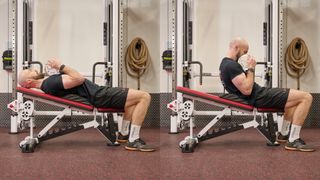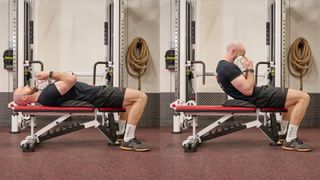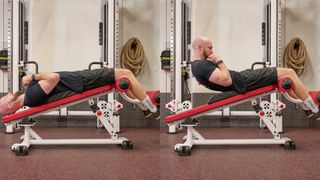
There is no shortage of abs workouts on the internet. But which of the dozens, if not hundreds, of abs exercises should you focus on? Which are a waste of time? And how often should you train your abs anyway?
To help you make the most of your time, we consulted Nick Mitchell, the founder and CEO of Ultimate Performance. Mitchell is a highly respected fitness industry veteran who’s single-handedly responsible for more six-packs than you’ve had hot dinners.
With Mitchell on board, we’ve drawn up this comprehensive abs workout guide, suitable for complete novices and experienced exercisers alike. Below you will learn all about the muscles that make up the classic six-pack, the truth about belly fat, why you should build your abs workouts around compound exercises, and how to directly train your abs over the course of five weeks to guarantee progress.
Buckle up, we’re going in.
How To Get Abs
We all have abs, but for most they’re hidden beneath a layer of body fat. To reveal your abdominal muscles, most men need to have a body fat percentage of around 10% (it’s around 15-20% for women).
“If you can pinch more than an inch around your midsection, following a specific fat-loss plan will help to reveal your abs,” Mitchell says (there are more complex and up-to-date ways to measure body fat).
That said, it’s not just about how lean you are. “Anybody with low body fat can have abs, no matter how strong or muscular you are,” Mitchell continues. “But abs on a skinny guy who can’t bench his bodyweight just isn’t impressive. For a set of abs to be truly special, you need a good level of strength and muscle across your whole body.”
Get the Coach Newsletter
Sign up for workout ideas, training advice, reviews of the latest gear and more.
In Mitchell’s book, that means strength training.
The Abdominal Muscles Explained
Before diving head first into an abs workout, it’s worth considering which muscles make up the six-pack musculature and the various functions of the abdominals in order to train them effectively.
The six-pack is made up of four muscle groups:
- Transversus abdominis: This deep-lying muscle holds your ribs in position and stabilizes the pelvic region.
- Rectus abdominis: This sheet of muscle is divided into segments, providing the six-pack look.
- Internal obliques: These broad muscles frame the six-pack, enabling side flexion and rotation.
- External obliques: Similarly involved in side flexion and rotation, these lateral abs muscles also pull the chest down and compress the abdominal cavity to help brace your core.
“Working in unison, the abdominal muscles that make up the six-pack region have two key functions,” says Mitchell.
- Movement of the spine (flexion, side-bending and rotation)
- Stabilization of the spine (resistance to flexion, side-bending and rotation)
Both functions should be drilled rigorously and regularly. “However, complex compound exercises such as back squats, deadlifts, overhead presses and pull-ups should form the cornerstone of your training plan if you want eye-catching abs,” says Mitchell.
That’s because you can’t squat, deadlift, overhead press or pull-up without working your abs. “These movements tend to involve heavy loads exerted on the body, which requires large amounts of muscular force,” Mitchell elaborates. “And it’s this transfer of muscular force through the body that best helps develop abdominal musculature.”
The Best Abs Workout For Beginners
If this is the very beginning of your six-pack journey, it’s best to start simple and build slowly. “If abs are your goal, the majority of your training should be focused around the major compound lifts and working to get progressively stronger,” says Mitchell.
However, if your heart is set on training your abs in isolation, there are a few things Mitchell suggests you try to keep in mind.
1. Keep It Simple
“Most abs exercises I see people perform outside of my gyms are too advanced and often butchered in their execution,” he says. “I prefer to limit the options to two or three proven exercises, then focus on getting progressively stronger.”
2. Consistency Is Key
“Treat your abs like any other body part split,” says Mitchell. “Think of training them just like you would for your chest or back. The last thing you should be doing is changing your workout or exercises every single session.”
3. Focus On Flexion
“Beginners, in my view, should primarily focus on abdominal crunches,” says Mitchell. This is because they drill one of the main functions of the abdominal muscles—spinal flexion. “Crunches are a common exercise but rarely are they done right.”
4. Finetune Your Form
“To make the most of this effective exercise, I recommend using an abdominal crunch pad, or ab mat, that you should be able to find in most commercial gyms,” says Mitchell. “This allows for a greater range of motion—and a greater range equals greater stimulation, a greater challenge and, ultimately, a greater six-pack.”
5. Vary The Point Of Attack
“While you shouldn’t mix up your exercises too often, I do recommend switching up the angle of attack so you don’t hit a plateau,” says Mitchell. “Perform crunches on the floor, on a bench with a slight incline and on a decline bench to keep progressing.”
6. Add Resistance
“At some point your bodyweight is unlikely to present enough of a challenge to keep you getting stronger,” says Mitchell. “That’s why it’s crucial to add load. I like to hug a dumbbell into my chest to make it more challenging. Alternatively, replicate the movement with the rope attachment on a cable machine to provide resistance.”
How To Do This Abs Workout
To put this six-step plan into action, Mitchell has devised a simple five-week abs workout built around the abdominal crunch exercise.
Progressive overload is achieved by slightly adjusting the number of reps, tempo, resistance and angle of attack over the four weeks. After four weeks, Mitchell suggests adding a second exercise, performed as a superset with minimal rest between sets.
You can add these core finishers to the end of your regular training session or use them as short and sweet standalone abs workouts. If doing the latter, add a five-minute pre-workout warm-up to minimize the risk of injury.
Week 1
1 Incline abdominal crunch

Sets 3 Reps 10-12 Tempo 3111 Rest 60sec
Set a weight bench to a shallow 10˚ incline and use an ab mat under your lower back to increase the range of motion for the exercise. Keep your feet flat on the floor, cross your arms and tuck your chin in to your chest. Curl your upper body off the bench until your torso is almost upright, maintaining tension in your abdominal muscles throughout, then lower under control. To achieve the 3111 tempo, lower for a count of three seconds, pause for one, drive up for one, pause for one.
Week 2
1 Weighted incline abdominal crunch

Sets 3 Reps 10-12 Tempo 3112 Rest 60sec
Perform the exercise as above while holding a single dumbbell against your chest to increase the level of resistance. Hold the weight in both hands, with your elbows tucked in to your body. Pause for a count of two seconds at the top of the exercise, contracting your abs muscles hard to increase their time under tension.
Week 3
1 Weighted abdominal crunch

Sets 3 Reps 12-15 Tempo 3112 Rest 60sec
This exercise should be performed flat on the floor, increasing the difficulty level. Position an ab mat under your lower back, keep your feet flat on the floor and hold a dumbbell across your chest as you curl your upper body up. Pause for two seconds at the top of the exercise, contract your abs hard, then lower slowly. Inhale as you lower, exhale as you curl up, and perform each rep with complete control.
Week 4
1A Weighted abdominal crunch

Sets 3 Reps 10-12 Tempo 3112 Rest 30sec
Perform the abdominal crunch on the floor, using an ab mat and dumbbell to increase the range of motion and resistance. Once all reps are complete, rest for just 30 seconds, then move on to exercise 1B.
1B Decline abdominal crunch

Sets 3 Reps 10-12 Tempo 2212 Rest 90sec
This exercise mirrors the incline abdominal crunch, but should be performed on a weight bench set to a shallow 10° decline so you have to fight that little bit harder against gravity. Note that the tempo is slightly different here too. Lower for two seconds, pause for two, drive up for one, pause for two. Rest for 90 seconds, then return to exercise 1A to start the second superset.
Week 5
1A Weighted abdominal crunch

Sets 3 Reps 10-12 Tempo 3112 Rest 30sec
Perform the abdominal crunch on the floor, using an ab mat and dumbbell, as detailed above.
1B Decline cable machine abdominal crunch

Sets 3 Reps 10-12 Tempo 2212 Rest 90sec
Position the head end of a weight bench next to the pulley station of a cable machine. Set the bench at a shallow 10° decline and the cable machine with a rope handle set at its lowest position. Lying on the bench, again using an abmat, grasp the handles of the rope so that your hands are next to your head. Keeping your elbows locked in position, contract your abs to curl your upper body off the bench until almost upright. Keep the weight stack light to ensure good form throughout this technical exercise.
The Best Abs Workout Plan
Now you know how to use the crunch to progressively strengthen your core. Your next challenge will be introducing functional abdominal movements to further improve your core stability, while providing cross-over benefits for all your other lifts and any sports you play as well.
At this stage, your abs workout exercise selection should be determined by your general strength and fitness level. The hanging leg raise, for example, is an excellent, advanced core exercise, but if your grip doesn’t allow you to hang on to a pull-up bar long enough for an effective set, it won’t provide the stimulus you need.
“You would be better off picking an exercise that allows you to target your abs in a more isolated manner without other body parts breaking down first,” says Mitchell.
So, which exercises should you pick? Mitchell recommends including one or two moves for every major core function. “That means exercises that include flexion of the spine, such as crunch variations, side bends, rotational movements and something that will present an adequate stabilization challenge.”
Here, Mitchell has picked his go-to abdominal exercises for each major core function, based on ability levels from beginner to advanced.
Beginner Abs Workout Exercise Options
| Spinal flexion | Lateral flexion | Rotation |
|---|---|---|
| Bodyweight incline abdominal crunch | Suitcase carry (unilateral farmer’s walk) | Seated cable wood chop (horizontal cable) |
| Abdominal crunch | Side bend performed on floor/bench | Row 1 - Cell 2 |
Intermediate Abs Workout Exercise Options
| Spinal flexion | Lateral flexion | Rotation |
|---|---|---|
| Weighted abdominal crunch | Incline side bend (performed on 45° incline back extension bench) | Standing cable wood chop (horizontal cable) |
| Bodyweight decline abdominal crunch | Row 1 - Cell 1 | Row 1 - Cell 2 |
Advanced Abs Workout Exercise Options
| Spinal flexion | Lateral flexion | Rotation |
|---|---|---|
| Weighted decline abdominal crunch | Horizontal side bend (performed on flat back extension bench) | Standing low-to-high cable woodchop |
| Cable machine abdominal crunch | Row 1 - Cell 1 | Standing high-to-low cable woodchop |
| Reverse crunch | Row 2 - Cell 1 | Row 2 - Cell 2 |
| Hanging leg raise | Row 3 - Cell 1 | Row 3 - Cell 2 |

Sam Rider is an experienced freelance journalist, specialising in health, fitness and wellness. For over a decade he's reported on Olympic Games, CrossFit Games and World Cups, and quizzed luminaries of elite sport, nutrition and strength and conditioning. Sam is also a REPS level 3 qualified personal trainer, online coach and founder of Your Daily Fix. Sam is also Coach’s designated reviewer of massage guns and fitness mirrors.
